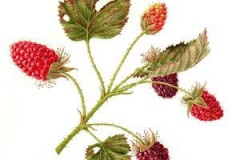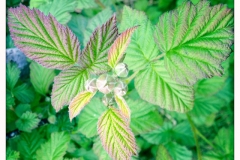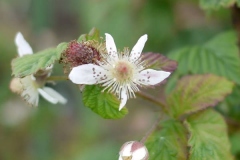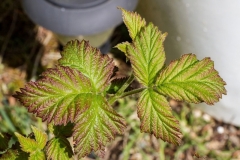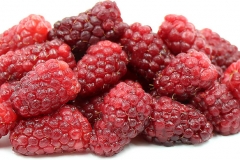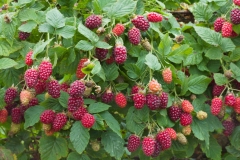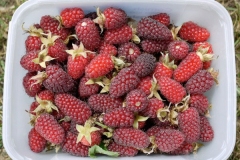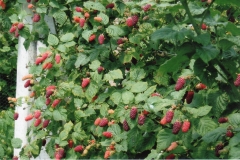| Tayberry Quick Facts | |
|---|---|
| Name: | Tayberry |
| Scientific Name: | Rubus fruticosus x idaeus |
| Origin | Scotland |
| Colors | Reddish-purple color when fully ripe |
| Shapes | Cone shaped fruit measure up to 4 cm (1.5 inches) in length. |
| Taste | Slightly Acidic |
| Health benefits | Delays signs of ageing and lowers cholesterol, Provides essential iron, Regenerates and repairs body cells, Helps in the growth of DNA and RNA, Prevents neural tube defects in infants, Used in making tasty wine, Cures diarrhea, gum problems, Beneficial for skin and hair, Excellent source of antioxidants, Reduces unwanted body fats, Helps to maintain optimal blood sugar levels, Prevents risks of colon cancer |
| Name | Tayberry |
|---|---|
| Scientific Name | Rubus fruticosus x idaeus |
| Native | Scotland |
| Common Names | Tayberry |
| Name in Other Languages | Afrikaans: Tayberry Albanian: Tayberry Amharic: Tayberry Arabic: Taybyry (تايبيري) Armenian: Tayberry Azerbaijani: Tayberry Bengali: Tayberry Bulgarian: Tayberry Burmese: Naypyitaw (နေပြည်တော်) Chinese: Tài bó lǐ (泰伯里) Croatian: Tayberry Czech: Tayberry Danish: Tayberry Dutch: Tayberry English: Tayberry Esperanto: Tayberry Estonian: Tayberry Filipino: Tayberry Finnish: Tayberry French: Tayberry Georgian: T’eibri (ტეიბრი) German: Taylorberry Greek: Vatómouro (βατόμουρο) Gujarati: Ṭēyabērī (ટેયબેરી) Hausa: Tayberry Hebrew: טייבר Hindi: Tayberry Hungarian: Tayberry Icelandic: Tayberry Indonesian: Tayberry Irish: Tayberry Italian: Tayberry Japanese: Teiberī (テイベリー) Javanese: Tayberry Kannada: Ṭēberri (ಟೇಬೆರ್ರಿ) Kazakh: Tayberka (тайберка) Korean: Tayberry Kurdish: Tayberry Lao: Tayberry Latin: Idaeus Latvian: Tauriņš Lithuanian: Silkmedis Macedonian: Tejberi (Тејбери) Malagasy: Tayberry Malay: Tayberry Malayalam: Teybeṟi (ടെയ്ബെറി) Maltese: Tayberry Marathi: Tebaree (टेबरी) Mongolian: Takhiany makh (тахианы мах) Nepali: Taayaberee (टायबेरी) Norwegian: Tayberry Oriya: ଟାଏବେରୀ | Pashto: ټایبری Persian: تيبري Polish: Tayberry Portuguese: Tayberry Punjabi: Ṭē abērī (ਟੇਅਬੇਰੀ) Romanian: Tayberry Russian: Tayberry Serbian: Taiʙerri (таиберри) Sindhi: ٽي بيري Sinhala: Tēberi (ටේබෙරි) Slovenian: Tayberry Spanish: Tayberry Sudanese: Tayberry Swedish: Tayberry Tajik: Taybr (тайбр) Tamil: Ṭēperri (டேபெர்ரி) Telugu: Tayberry Thai: Tayberry Turkish: Tayberry Ukrainian: Malina (малина) Urdu: ٹائی بیری Uzbek: Tayber Vietnamese: Tay dâu Welsh: Mwyar Mair Zulu: I-tayberry |
| Plant Growth Habit | Vigorous, trailing or arching, deciduous shrubs |
| Growing Climates | Warm, sunny to partially shaded and somewhat sheltered places |
| Soil | Moderately moist, slightly acidic-slightly calcareous, well drained soil with a high amount of organic materials |
| Plant Size | Will reach a height of 2.5m and a spread of 0.5m |
| Stem | Stout, thorny stems bearing lobed |
| Leaf | Leaves are green, heart-shaped, pointed and toothed. Upper leaf is pale green and the undersides are white usually with five leaflets |
| Flowering season | May to September |
| Flower | Flowers are white, with noticeably wide-spaced petals, they appear as early as late April to early May. The flowers are hermaphrodite (have both male and female organs) and are pollinated by bees |
| Fruit Shape & Size | Cone-shaped fruit can measure up to 4 cm (1.5 inches) in length |
| Fruit Color | Reddish-purple color when fully ripe |
| Propagation | By tip layering or from cuttings |
| Taste | Slightly Acidic |
| Plant Parts Used | Fruits, leaves |
| Season | June to October |
Plant Description
Tayberry is a vigorous, trailing or arching, deciduous shrub that normally reaches a height of 2.5 m and a spread of 0.5 m. Tayberries normally like warm, sunny to partially shaded and somewhat sheltered places. The plant prefers moderately moist, slightly acidic-slightly calcareous, well-drained soil with a high amount of organic materials. It can be planted in spring or autumn. The plant stout, thorny stems bearing lobed. Leaves are green, heart-shaped, pointed and toothed. Upper leaf is pale green and the undersides are white usually with five leaflets. The flowers are white, with noticeably wide-spaced petals, they appear as early as late April to early May. The flowers are hermaphrodite (have both male and female organs) and are pollinated by bees.
Fruits
Tayberry fruit are cone shaped and are a reddish-purple color when fully ripe. They can be up to 4 cm (1 1⁄2 in) long. Similar to the blackberry, the receptacle (the core) remains in the berry when it is picked. The tayberry is less acidic than the loganberry, with a strong flavor. The plant has a growth habit similar to that of the blackberry. The cropping period is long, from early mid to late summer. When fully ripe, the berries are very soft, but only then develop their full aroma.
Health Benefits of Tayberry
Listed below are some of the popular health benefits of tayberry
1. Delays signs of ageing and lowers cholesterol
Tayberry is loaded with Vitamin C, which makes it a citrus fruit. It helps in healing wounds fast and fights against the free radicals, delaying signs of ageing. It is also helpful for reducing the cholesterol level in the body.
2. Provides essential iron
Iron, which is essential for the body, is found in high quantities in tayberry. If your body is deficient in iron, you will suffer from anemia. So tayberry helps you to treat anemia and makes you healthy.
3. Regenerates and repairs body cells
Tayberry is rich in flavonoids, which help in regenerating the body cells as well as repair the cells. So small children and pregnant women benefit a lot by consuming tayberry.
4. Helps in the growth of DNA and RNA
RNA and DNA are the building blocks of the body cells and tayberry helps in the growth and development of RNA and DNA. Having tayberry everyday prevents any changes that may take place in DNA, which can lead to cancer and other such major problems.
5. Prevents neural tube defects in infants
Pregnant women benefit a lot by consuming this fruit as it aids in preventing neural tube defects in the new born baby.
6. Used in making tasty wine
Tayberry is used to make tasty wines. The wine thus made has lots of health benefits the taste is very refreshing, quite different from other blends of wines. This wine has a sweet and tart taste and is red in color. A glass of tayberry wine taken regularly is said to make your immune system strong.
7. Cures diarrhea, gum problems
People suffering from diarrhea will find tayberry helpful as consuming this fruit would bring instant relief. Chewing and munching the tayberry fruits as well as the leaves of this plant helps to prevent the body from being dehydrated due to diarrhea, while the dietary fiber present in the fruit absorbs additional water. Those suffering from bleeding gums will also find the leaves of this plant beneficial. It is said to cure all types of gum problems. Simply chewing the leaves of tayberry plant effectively cure bleeding gums.
8. Beneficial for skin and hair
Tayberries are also beneficial for the health of your skin and hair. Make a paste of the fruit, which is loaded with vitamins and antioxidants, and apply it on your skin or to your hair for nourishment. While it will provide nourishment to the hair follicles making the hair healthy and thick, your skin will be smooth and have a youthful glow.
9. Excellent source of antioxidants
If you wish to remain healthy and fit, you need to intake plenty of fruits and vegetables containing antioxidants. Antioxidants help to counteract and eliminate all harmful free radicals, thereby protecting us from various diseases. Tayberry is rich in antioxidant content and consuming this fruit helps to keep you healthy. Hence, you should eat more tayberries to increase the presence of antioxidants in your body.
10. Reduces unwanted body fats
Consuming tayberries helps to reduce the unwanted fats in the body, thus aiding weight loss. This ability of the fruit is attributed to the high concentration of antioxidants in it. By cutting down on the accumulated fats, tayberry also helps to keep you healthy and fit.
11. Helps to maintain optimal blood sugar levels
Unexpected rise in the levels of blood sugar can often lead to serious health conditions, including diabetes. Therefore, consuming enough tayberries on a regular basis helps to check the blood sugar levels and prevent diabetes, thereby ensuring your overall wellbeing.
12. Prevents risks of colon cancer
Intake of sufficient amount of tayberry on a regular basis can help in avoiding the risk of developing colon cancer and other serious health conditions. Since these berries are rich in antioxidant content, they help to eliminate the detrimental free radicals, which are responsible for various forms of cancer and other serious diseases. Aside from free radicals, consumption of tayberry also helps to eliminate all types of harmful chemicals from the body.
Traditional uses and benefits of Tayberry
- Tayberry offers a number of health benefits, especially lowering the cholesterol levels and holding up the signs of aging.
- Consumption of tayberries helps to heal wounds quickly.
- Tayberry can not only help you to get rid of anemia, but also maintain your overall health.
- Consuming tayberry is highly beneficial for pregnant women as this fruit helps to prevent any defects in the neural tubes of newborns.
- Tayberry is also helpful for lactating mothers.
Culinary Uses
- The fruit is eaten uncooked or made into fruits spreads or desserts.
- Macerated Tayberries can be added to cocktails or smoothies.
- Cooked down and sweetened they can be used to make sauces, ice cream, and sorbet.
- Tayberries are also ideal for making berry crumble or pies.
- You may also serve the raw fruit as a spread for waffles, cream scones, pikelets and even pancakes.
- You can also use tayberries to prepare a wonderful jam and add them to various fruits such as apples and to pies.
- A wine made from tayberries has several happy aficionados.
- You can also macerate tayberries in cider vinegar, gin, vodka or brandy.
References:
https://en.wikipedia.org/wiki/Tayberry



